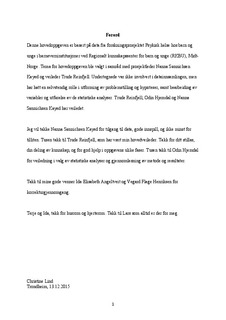Chronic pain across psychiatric disorders, and their impact on health-related quality of life : a study of the Norwegian residential youth care population
Master thesis
Permanent lenke
http://hdl.handle.net/11250/2400012Utgivelsesdato
2015Metadata
Vis full innførselSamlinger
- Institutt for psykologi [2941]
Sammendrag
Background: Adolescents in residential youth care (RYC) are at risk for impaired mental and physical health, but the knowledge of chronic pain and Health-Related Quality of Life
(HRQOL) in this population is scarce. The aim of this study was to investigate the prevalence of chronic pain, chronic pain across psychiatric disorders, and HRQOL, in adolescents in the Norwegian RYC.
Methods: This study was part of a large scale, nationwide study of the RYC in Norway,
administered at Regionalt kunnskapssenter for barn og unge (RKBU) Midt-Norge. Residents between the ages of 12-20 living in RYC in Norway were the inclusion criteria. The total number of participants in the study came from 86 institutions, with 601 available adolescents. 201 adolescents/parents did not give their consent, so in total 400 adolescents aged 12-20 participated (67 %). The participants were assessed through a cross-sectional approach using the Kinder Lebensqualität Fragebogen (KINDL-R) to measure health-related quality of life. Further, the adolescents were interviewed using the Child and Adolescent Psychiatric interview (CAPA) in the assessment of psychiatric disorders (DSM-IV), and to measure chronic pain symptoms.
Results: The prevalence of chronic pain in the total sample was 42%. Among adolescents
with a psychiatric disorder, 59.6% reported chronic pain. Adolescents with emotional- and
anxiety disorders had the highest prevalence of chronic pain. Girls reported a significantly
higher frequency of chronic pain. Age and placement status did not have any statistically
significant influence on the frequency of chronic pain. Self-reports of HRQOL revealed that
both chronic pain and psychiatric disorders are associated with significantly poorer HRQOL compared to those not having chronic pain or a psychiatric disorder. Having both a chronic pain condition and a psychiatric disorder was associated with significantly poorer HRQOL compared to having either chronic pain or a psychiatric disorder.
Conclusions: There is a relatively high prevalence of chronic pain in the RYC population,
both in adolescents with and without a psychiatric disorder. Both chronic pain and psychiatric disorders have a significant negative impact on levels of HRQOL, and the findings indicate the importance of improving factors associated with impaired HRQOL in the RYC population.
